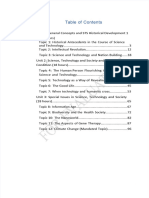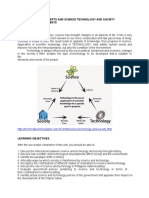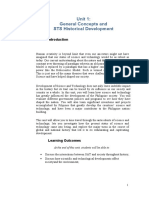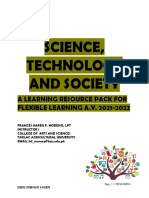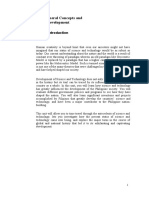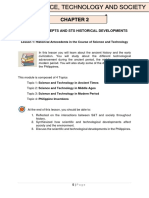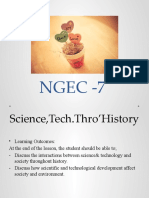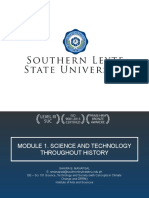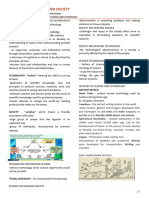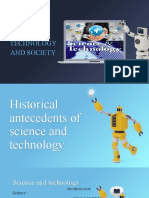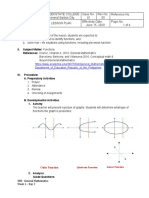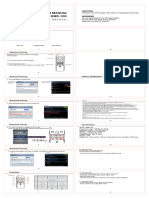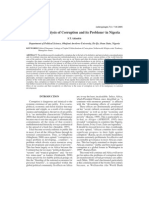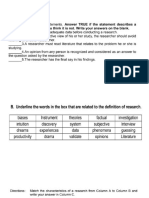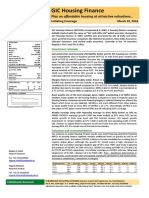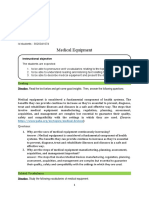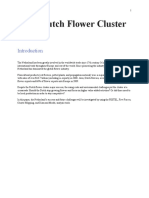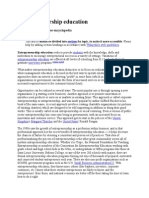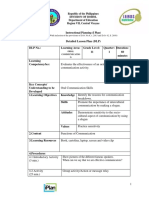STS Module
Uploaded by
allyssa0231575STS Module
Uploaded by
allyssa0231575Bachelor of Elementary Education (BEED)
LEARNING MODULE
Module Number 1
Subject Code: GEC-8
Subject Description: Science and Technology And Society
Term: First Semester Academic Year 2022-2023
I. Learning Objectives
Upon completion of this module, the students will be able to:
1. Discuss the interactions between science and technology society throughout history.
2. Discuss how scientific and technological developments affect society and the
environment.
3. Identify the paradigm shifts in history.
4. Articulate ways by which society is transformed by science and technology.
5. Discuss the role of science and technology in Philippine nation.
6. Evaluate government policies pertaining to science and technology in terms of their
contributions to nation building
7. Identify actual science and technology policies of the government and appraise their
impact on the development of the Filipino nation.
8. Analyze the human condition in order to deeply reflect and express philosophical
ramifications that are meaningful to the student as a part of society.
9. Examine shared concerns that make up the good life in order to come up with
innovative creative solutions to contemporary issues guided by ethical standards.
II. Learning Outcomes:
1. Articulate the impacts of science and technology on society, specifically Philippine
society.
2. Analyze human condition in order to deeply reflect and express philosophical
ramifications that are meaningful to the student as a part of society.
3. Organize the importance of science and technology in the preservation of the
environment and the development of the Filipino nation.
4. Foster the value of healthy lifestyle toward the holistic and sustainable development
of society and the environment.
5. Creatively present the importance and contributions the science and technology to
society.
6. Illustrate how the social media and information age impact their lives and their
understanding of climate change.
III. Learning Resources:
Modules, Textbooks and YouTube videos
IV. Tasks to Complete
Activities
Quizzes
Examination
V. Content Items
UNIT 1: General Concepts and Historical Events in Science,
Technology, and Society
Lesson 1: Historical Antecedents in the Course of Science and Technology
P eople were concerned with transportation and mobility in ancient times. Navigation,
communication, and record keeping, mass production, security and protection, as
well as health, aesthetics, and architecture are all examples of engineering. Science
and technology continue to advance in order to address the increasing requirements of
Page 1 of 27 Prepared by: Mrs. Sherlet D. Canilang, LPT
people in these areas. Our society responds by evolving as a result of the ongoing
innovation offered by Science and Technology, with the final goal of enhancing lives and
making work easier, faster, and more efficient. These developments are visible as each
ancient culture continues to develop technology that has been changed and is now
employed.
Sumerians are famous for developing the first writing system known as cuneiform. To
meet the challenge of mass producing food, they created plowing, irrigation, dikes, and
wheels for farming. All through the existence of this civilization, their primary form of
movement was via waterways such as rivers and oceans. They are also credited with
creating the first road. The Babylonian Civilization, on the other hand, which evolved
around the Tigris and Euphrates Rivers, was known for its brilliant builders, engineers, and
architects. The hanging garden of Babylon, one of the world's seven wonders, is one of the
significant contributions.
The Egyptian Civilization is well-known for its iconic archeological artifacts such as the
death mask of Tutankhamen and the Pyramid of Giza. Furthermore, the ancient Egyptians
are noted for their earlier contributions such as the water clock or clypsedra, paper or
papyrus, ink, and a writing system known as hieroglyphics. They also developed cosmetics
for aesthetic purposes. Meanwhile, rich Egyptians wore wigs to cover their shaved heads
from the sun's harmful rays during this time period.
Aside from being the origin of western philosophy, some of the Greek Civilization greatest
achievements include in-depth works on philosophy and Mathematics. They are also
honored for their contributions to the world, such as the coliseum, the Olympics, the alarm
clock, and the water mill.
The Roman Empire was seen as the strongest political and social institution in the western
world, and it was regarded as the cradle of politics and governance. In terms of written
laws and legislation, other civilizations looked to it as a model. They are also credited with
the invention of the newspaper, bound books, and the codex. Romans are famed for their
grandiose cathedrals, basilicas, aqueducts, coliseums, amphitheaters, and residential
houses in terms of architectural and engineering. They also created their own number
system, the Roman Numeral System.
China, the oldest civilization in Asia, is famous for its silk, Trade, tea manufacturing, gun
powder, and China's Great Wall.
Science and Technology in Middle Ages
Massive invasions and migrations impaired the beginning of the Middle Ages. Wars are
common at this time. As a result, considerable technological advances were required in the
realms of weaponry, navigation, food and farm production, and health care. Population
reduction has resulted from the wars. However, there was a large growth in population in
the latter part of this time. Boosted international trade and business increased need for
transportation technology. This period produced some of the most creative brains.
Because the Middle Ages were also known as the Age of Exploration, there was a great
demand for maritime inventions. The invention of the telescope, an optical tool used to
observe distant objects, was a huge assistance to navigators at the time. This age also saw
significant advancements in armament technology. Crossbows and longbows are examples
of this. Furthermore, in close-range hand-to-hand combat, soldiers should wear something
to defend themselves, which is a must. This was addressed by the development of iron
body armors However, body armors were heavy and restricted warriors' movements;
chainmail was designed to remedy this problem.
Science and Technology in Modern Times
Page 2 of 27 Prepared by: Mrs. Sherlet D. Canilang, LPT
The growing global population from the nineteenth century onwards asked that more
things be manufactured at a faster rate People required efficient modes of transportation in
order to sell more commodities and travel a greater distance. Machines that rely on animals
must thus be improved. To establish linkages between and among nations, faster and easier
ways of communication and computation should be developed. All of these requirements
led to the formation of industries.
Science and Technology in the Philippines
Science and technology in the Philippines had experienced periods of intense growth as
well as long periods of stagnation. The main managing agency responsible for science and
technology is the Department of Science and Technology. Numerous national scientists
have contributed in different fields of science including Fe del Mundo in the field of
Pediatrics, Eduardo Quisumbing in the field of Plant taxonomy, Gavino Trono in the field of
tropical marine Phycology, Maria Orosa in the field of Food technology and many more
PRE-SPANISH ERA
Even before the colonization by the Spaniards in the Philippine islands, the natives of the
archipelago already had practices linked to science and technology. Filipinos were already
aware of the medicinal and therapeutic properties of plants and the methods of extracting
medicine from herbs. They already had an alphabet, number system, a weighing and
measuring system and a calendar. Filipinos were already engaged in farming, shipbuilding,
mining and weaving. The Banaue Rice Terraces are among the sophisticated products of
engineering by pre- Spanish era Filipinos.
SPANISH COLONIAL ERA
The colonization of the Philippines contributed to growth of science and technology in the
archipelago. The Spanish introduced formal education and founded scientific institutions.
During the early years of Spanish rule in the Philippines. Parish schools were established
where religion, reading, writing, arithmetic and music was taught. Sanitation and more
advanced methods of agriculture were taught to the natives. Later the Spanish established
colleges and universities in the archipelago including the oldest existing university in Asia,
the University of Santo Tomas.
The Galleon Trade has an account in the Philippine colonial economy. Trade was given
more focus by the Spaniard colonial authorities due to the prospects of big profits.
Agriculture and industrial development on the other hand were relatively neglected. The
opening of the Suez Canal saw the influx of European visitors to the Spanish colony and
some. Filipinos were able to study in Europe who was probably influenced by the rapid
development of scientific ideals brought by the Age of Enlightenment.
Lesson 2: Intellectual revolutions that defined society
T
Nicolaus Copernicus - The Man who moved the Sun
he way people think about Solar System has changed many
times throughout history. Before the development of
telescope astronomy beliefs were based on what can be
seen by the naked eye. One of the earliest ideas on how Solar
System was structured was introduced by Claudius Ptolemy. He
posited that planets as well as the sun and the moon, moved in a
circular motion around the Earth, a concept which is known as
geo-centrism. This geocentric model, considered to be one of the
Page 3 of 27 Prepared by: Mrs. Sherlet D. Canilang, LPT
greatest discoveries of all time, was widely accepted by the people and became the
astronomical dogma in Western civilization for 1,400 years.
In the 16th century, Nicolaus Copernicus challenged the geocentric model by putting sun at
the center of the solar system and known as the concept of heliocentrism. This idea was
rejected at first by the public. It appalled many since their religious belief had taught them
that the Earth was created first before all other things. Copernicus was even persecuted as
a heretic.
Charles Darwin and the Theory of Evolution by Natural
C
Selection
harles Darwin was an English naturalist who studied
variation in plants, animals and fossils during a five-year
voyage around the world in the 19th century. Darwin's
theory of evolution challenged the idea that God made all the
animals and plants that live on Earth in a single day, which
contradicted the commonly held Christian views of his era. He
did not publish his scientific work and ideas until 28 years after
his voyage.
Finally, as a result of Darwin's world expedition and
observations, which were enhanced by many years of
experimentation, his discussions with like-minded scientists and his developing knowledge
of geology and fossils, he proposed the theory of evolution by natural selection. Darwin
proposed that: individual organisms within a particular species show a wide range of
variation for a characteristic, individuals with characteristics most suited to the
environment are more likely to survive to breed successfully; and the characteristics that
have enabled these individuals to survive are then passed on to the next generation. This is
called Theory of Evolution by Natural Selection.
I
Sigmund Freud - the Father of Psychoanalysis
n the past, the field of Psychology was always classified under
philosophy. Psychology was considered more of an art rather
than a science. In the late 19th century, Sigmund Freud was
able to change people’s perception of psychology with his
revolutionary theory of psychoanalysis. Psychoanalysis is the
study of human behavior. In his theory, Freud explained that
there are many conscious and unconscious factors that can
influence behavior and emotions. He also argued that personality
is a product of three conflicting elements: id, ego and superego.
Despite criticisms, Freud still continued to work on refining his theory and in fact tried to
explain how psychoanalysis can be a clinical method in treating
some mental disorders. Soon enough, people were able to understand the concepts of
psychoanalysis, which eventually resulted in classifying psychology as a science.
Lesson 3: Science and Technology and nation building
Science and Technology in the Philippines
Even in Philippines during precolonial times up to modern times, the advancement of
Science and Technology has been equated to socio-economic progress and political
sovereignty and security.
Page 4 of 27 Prepared by: Mrs. Sherlet D. Canilang, LPT
Brief Historical Background of Science and Technology in the Philippines Pre –
Colonial Period
Even before the Spain colonized the country, some indigenous science and technology has
already existed with regards to agriculture like farming, animal – raising, and the utilization
of plants and herbs as medicines. The use of technology is evident in the in handicrafts,
pottery, weaving, and tools used by ancient Filipinos in their everyday life.
Innovation and ingenuity were unmistakable by the way native Filipinos built the rice
terraces by hand. They also developed tools for planting, hunting, cooking, fishing, and also
for fighting enemies during tribal conflicts. They used indigenous technology in building
houses, irrigations and transportation, both on land and on waterways.
The ancient practices in science and technology by our ancestors are now considered as
indigenous science or folk science.
Colonial Period
Spanish colonization paved way to modern means of construction. Roads, bridges,
churches, and other large infrastructures were built with more sophistication using some
engineering skills and tools brought by the Spaniards. In addition, Spanish colonizers
developed health and education system in the country.
The American colonial rule modernized almost all aspects of life in the country. They
established the Bureau of Science to initiate the development in the field of science and
technology.
Post – Colonial Period
After achieving independence from the colonial masters, the Philippines, under different
administrations, continued to pursue programs in science and technology. Each leadership
had its own S&T agenda. However, it is important to note that some Philippine presidents
introduced more developments in the field than others, which you will find out soon as you
course through this topic.
Filipino Presidents and their Contributions in the Development of Science and
Technology in the Philippines
Philippine Presidents and the Status of S&T during their administration
Pres. Carlos P. Garcia (1957 - 1961)
lack of support of experimental work -marginal budget for
scientific research
low salaries of scientists employed by the government
established the National Science Development Board
Page 5 of 27 Prepared by: Mrs. Sherlet D. Canilang, LPT
Pres. Ferdinand Marcos (1965 - 1986)
directed the Department of Education to revitalize the science
courses in public high schools
channelled additional funds to support projects in applied
sciences and science education
he proclaimed 35 hectares in Bicutan, Taguig, Rizal as the site of
the Philippine Science Community
scholarships for graduate and undergraduate science scholars,
and workshops on fisheries and oceanography
added the Philippine Coconut Research Institute to the NSDB to
modernize the coconut industry.
support for the promotion of scientific research and invention
with Presidential Decree No. 49, s. 1972
he enacted a law under Presidential Decree No. 1003-A, s. 1976 to establish the
National Academy of Science and Technology
He enacted a law on the completion of the National Agriculture and Life Sciences
Research Complex at the University of the Philippines at Los Baños (Executive Order
No. 840, s. 1982)
he established the Mindanao and Visayas campuses of the Philippine Science High
School to encourage careers in science and technology
established other research institutes like PAGASA, National Grains Authority,
Philippine Council for Agricultural Research, Philippine National Oil Company
among others
Pres. Corazon Aquino (1986 - 1992)
National Science and Technology Authority was replaced by the
Department of Science and Technology
science and technology's role in economic recovery and sustained
economic growth was highlighted
created the Presidential Task Force for Science and Technology
which came up with the first Science and Technology Master Plan
or STMP
Executive Order No.128 abolished R.A. No. 3859, also known as
the “Philippine Inventors Incentive Act.”
gave assistance to Filipino inventors through giving financial aid, patent application
assistance, legal assistance, and to help inventors market their products
domestically and abroad
R.A. 6655 or the Free Public Secondary Education Act of 1988 opened doors to free
education up to the secondary level
“Science for the Masses Program” which aimed at scientific and technological
literacy among Filipinos
Pres. Fidel V. Ramos (1992 - 1998)
significant increase in personnel specializing in the science and
technology field -addition of Philippine Science High Schools in
Visayas and Mindanao
government provided 3,500 scholarships for students who were
taking up professions related to S&T
Schools were becoming more modernized and updated with the
addition of hightech equipment for student
Priority for S&T personnel increased when Magna Carta for
Science and Technology Personnel (Republic Act No. 8439) was established
Page 6 of 27 Prepared by: Mrs. Sherlet D. Canilang, LPT
award was published in order to give incentives and rewards for people who have
been influential in the field of S&T (Inventors and Inventions Incentives Act or
Republic Act No. 7459)
programs such as National Program for Gifted Filipino Children in Science and
Technology
enactment of a law creating a nationwide system of high schools specializing in the
field of science and engineering (Science and Technology Scholarship Law of 1994)
enacted the Intellectual Property Code of the Philippines (Republic Act No. 8293)
Pres.
Joseph Estrada (1998 - 2001)
launched a full-scale program based on cost-effective
irrigation
technologies
establishment of one science high school in every province
advancement of industries and schools into the Internet age,
passage of the e-Commerce Act
Pres. Gloria Macapagal Arroyo (2001 - 2010)
the science and technology sector of the Philippines was
dubbed as the "golden age“ during her term
Numerous laws and projects that concerns both the
environment and science to push technology as a tool to
increase the country's economic level
the term "Filipinnovation" was the coined term used in helping
the Philippines to be an innovation hub in Asia
Science Technology and Innovations (STI) was developed
further by strengthening the schools and education system
such as the Philippine Science High School (PSHS), which
focuses in science, technology and mathematics in their curriculum
imposes Republic Act 10601 which improves the Agriculture and Fisheries Sector
through Mechanization (AFMech)
President Benigno S. Aquino III (2010 – 2016)
Educational reform by shifting to K – 12 educational system
Project NOAH (Nationwide Operational Assessment of Hazards)
is created in response to the call of President Noynoy Aquino for
a more accurate, integrated, and responsive disaster prevention
and mitigation system, especially in high-risk areas throughout
the Philippines.
Signed the E.O 2016 on May 20, 2016: Adopting the policy on
ensuring sustainable renewable energy resource management
and mandating the Department of Energy (DOE) to lead in its
implementation
Page 7 of 27 Prepared by: Mrs. Sherlet D. Canilang, LPT
President Rodrigo R. Duterte (2016 – present)
Tax Reform for Acceleration and Inclusion or TRAIN law was
signed in December 2017. It’s primarily a revenue-generating
measure to fund the administration’s infrastructure program,
health, education, and social services programs.
Signed the Balik Scientist Law (R.A. 11035) on 15 June 2018 that
would give more incentives to returning Filipino experts,
scientists, inventors, and engineers who would share their
expertise in the country.
Increased the budget of DOST yearly strengthening the S&T
capability of the country
Signed the Philippine Space Act in August 8, 2019 creating the Philippine Space
Agency (PhilSA)
The current administration supports the Philippine Space Program, which launched
space satellites Diwata – 1 and Diwata – 2 in 2016 and 2018, respectively
Moves ‘Science and Technology Week’ to November to ensure maximum
participation of schools, stakeholders and the public considering the change in the
academic calendar of most educational institutions
Republic Act (RA) No. 11293 otherwise known as the “Philippine Innovation Act”
was signed by President Duterte on April 17, 2019 in order to foster innovation in
the country as a vital component of national development and sustainable economic
growth.
Filipino Scientists and their Inventions
Here is a list of some Filipino scientists and inventors, together with their contributions in
shaping the science and technology of the Filipino nation.
Dr. Arturo Alcaraz
Dr. Arturo Alcaraz is a volcanologist specializing in geothermal energy development. In
1967, Arturo Alcaraz and team powered an electric light bulb using steam-powered
electricity. This was the first geothermal power generated in the Philippines.
Julian Banzon (1908 - 1988)
Filipino chemist, Julian Banzon researched methods of producing alternative fuels. Julian
Banzon experimented with the production of ethyl esters fuels from sugarcane and
coconut.
Pedro Escuro (1923 - )
Filipino scientist, Pedro Escuro is best known for his isolation of nine rice varieties, thus
was renowned by developing rice breeding in the country. The Pedro Escuro rice varieties
are: Milpal 4, HBD-2, Azmil 26 and C-22 and C-18, C4-63, C4-137, C-168 and C-12.
Dr. Francisco Fronda (1896 - 1986)
Dr. Francisco Fronda is known as the Father of poultry science in the Philippines. Francisco
Fronda has improved methods of production for the poultry and livestock industry.
Felix Maramba
Felix Maramba built a coconut oil-fueled power generator. He also is the developer of one
of the world's most profitable biogas systems.
Luz Oliveros Belardo (1906 - 1999)
Page 8 of 27 Prepared by: Mrs. Sherlet D. Canilang, LPT
Filipino chemist, Luz Oliveros Belardo researched the phytochemical properties of plants
in the Philippines for natural products, essential oils, and the medicinal qualities.
Emerita De Guzman
Filipino scientist Emerita De Guzman researched the propagation of pure macapuno trees.
Her research led to the faster propagation of pure macapuno trees and increased
macapuno nut production from 3-5 macapuno nuts to 14-19 nuts (1980). She also invented
tissue culture techniques for the rapid propagation of abaca and banana plants.
Dr. Fe Del Mundo (1911 - 2011)
Filipino doctor, Fe Del Mundo is credited with studies that lead to the invention of an
improved incubator and a jaundice relieving device
Gregorio Zara (1902 - 1978)
Famous Filipino Scientist, Gregorio Zara invented, made improvements to, or discovered
the following: invented the twoway television telephone or videophone (1955) patented as
a "photo phone signal separator network"; discovered the physical law of electrical kinetic
resistance called the Zara effect (around 1930); invented an airplane engine that ran on
plain alcohol as fuel (1952).
UNIT 2: Science, Technology, Society and the Human Condition
Lesson 1: Human Flourishing in terms of Science and Technology
A
Human Flourishing
ccording to Aristotle, there is an end of all of the actions that we perform which we
desire for itself. This is what is known as Eudaimonia, flourishing, or happiness,
which is desired for its own sake with all other things being desired on its account.
Eudaimonia, is a term that combines the Greek words for “good” and “spirit” to describe the
ideology. Eudaimonia defines happiness as the pursuit of becoming a better person.
Eudaimonia is a property of one's life when considered as a whole. Flourishing is the
highest good of human endeavors and that toward which all actions aim. It is success as a
human being. The best life is one of excellent human activity. Eudaemonists do this by
challenging themselves intellectually or by engaging in activities that make them spiritually
richer people.
For Aristotle, the good is what is good for purposeful, goal-directed entities. He defines the
good proper to human beings as the activities in which the life functions specific to human
beings are most fully realized. For Aristotle, person's nature as a human being provides him
with guidance with respect to how he should live his life. A fundamental fact of human
nature is the existence of individual human beings each with his own rational mind and
free will.
Principles of Human Flourishing
1. Dignity of Human Person – innate personal values or rights which demands respects
for all people, regardless of race, social class and wealth.
2. Common Good – sacrificing self-interest to provide for the basic human needs of
everyone makes the whole community flourish.
3. Preferential Option for the Poor – when decisions are made by first considering the
poor.
4. Subsidarity – when all those affected by a decision are involved in making it.
5. Universal Purpose of Goods – the Earth’s resources serve every persons’ needs,
regardless of who “owns” them.
Page 9 of 27 Prepared by: Mrs. Sherlet D. Canilang, LPT
6. Stewardship of Creation – duty to care for the Earth as a (God-given) gift is a
personal responsibility for the common good.
7. Promotion of Peace – everyone has the duty to respect and collaborate in personal
relationship and at national and global levels.
8. Participation – everyone has the right and the duty to take part in the life of a
society (economic, political, cultural, religious)
9. Global Solidarity – recognition that we are all interconnected, part of one human
family.
Lesson 2: Technology as a Way of Revealing
The Greek concept of the essence of technology was investigated by Martin Heidegger.
The meaning of technology for the Greeks was assumed to be part of our everyday life. To
clarify further, the term technology was defined into two categories.
1. Technology is a means to an end.
Technology as an instrument to achieve a purpose or end. For example,
student A bought a laptop and smartphone to be used for online learning
since students were not allowed to attend a face to face learning. The laptops
and smartphones are instruments for the student to achieve his/her purpose
which is to participate in online learning.
2. Technology is a human activity.
Technology is part of our daily activities of the human person which is to
invent technology such as gadgets for online learning, protective equipment
to fight COVID-19, agricultural machines to produce foods and etc.
The two definitions of technology are interconnected with each other in such a way that the
outcomes of human activities are meant to serve its purpose.
The Problems on Modern Technology
The Greek definition of technology as human activity and designed for a specific purpose
was restructured in modern times. Technology in the modern era was reduced into
calculative thinking that controls nature. For instance, the invention of the telescope, the
steam machine, and other devices was used to master nature. In the mastery of nature, we
used technology to manipulate things around us. To see a clear picture, Heidegger provided
three revelations on modern technology as challenging forth, enframing and dangerous;
Modern Technology as Challenging Forth
Heidegger claimed that ancient and modern technology are revealing. However, modern
technology is revealing not in the sense of bringing forth but rather challenging nature.
Modern technology challenging nature through extracting, transforming, storing, and
distributing it. Challenging forth reduced nature as standing 'reserve' or something to be
disposed of by the people. For examples, people exploited the natural resources without
minding the negative effects to the ecology, modernization of extracting gold, coal, and
petroleum from the ground compromised the bodies of waters, using of synthetic dyes and
artificial flavoring jeopardize human health, and the use of chemicals in the agriculture
poses threat to food safety and health security.
Modern Technology as Enframing
According to Martin Heidegger, modern technology is enframing. The term 'enframing'
derives from the word 'frame' which means putting something into a box. This
metaphorical term of Heidegger connotes that modern technology put nature into a box
through scientific knowledge. Enframing, according to Heidegger, is akin to two ways of
Page 10 of 27 Prepared by: Mrs. Sherlet D. Canilang, LPT
looking at the world; calculative thinking and meditative thinking. Humans put an order to
nature and control it through calculative thinking.
The Dangers of Technology
Heidegger at this point is critical to the dangers of modern technology by pointing out its
defects as enframing nature, challenging forth, treat nature as a standing reserve. In this
case, modern technology deviated from the essential notion of technology and revealing or
poiesis. Heidegger sees this as a danger to humanity. Recognizing its dangers of technology
requires critical and reflective thinking on its use. For example, social media has indeed
connected people in the most efficient and convenient way but it is prone to abuse such as
the invasion of privacy, online disinhibition, and proliferation of fake news. The real threat
of technology comes from its essence, not its activities or products. The correct response to
the danger of technology is not simply dismissing technology altogether. Heidegger
explained that people are delivered over to technology in the worst possible way when
they regard it as something neutral (Heidegger, 1997).
Lesson 3: The Good Life
What is Good Life as Perceived by different schools of thought?
I
Aristotle and Good Life
t is interesting to note that the first philosopher who approached the problem of reality
from scientific lens is Aristotle who is also the first thinker who dabbled into the
complex problematization of the end goal of life: happiness.
Compared to his predecessor and teacher, Plato, Aristotle embarked on different approach
in figuring out reality. Plato thought that things in this world are not real and are only
copies of the real in the world of forms. While Aristotle puts everything back to the ground
in claiming that this world is all there and that this world is the only reality, we can all
access.
Aristotle also forwarded the idea that there is no reality over and above what the senses
can perceive. As such, it is only by observation of the external world that one can truly
understand what reality is all about. Change is a process that is inherent in things. We,
along with all other entities in the world start as potentialities and move towards
actualities. The movement, of course, entails change.
Materialism
Materialism is a form of philosophical monism that holds that matter is the fundamental
substance in nature, and that all things, including mental states and consciousness are
results of material interactions. In this school of thought, happiness is measured by the
amount and kind of material things one possess.
In terms of human flourishing, material things are what make us attain happiness. The
material things we possess give us ultimate happiness and satisfaction. We see this at work
with most people who are clinging on to material wealth as the primary source of meaning
of their existence.
Hedonism
The word hedonism comes from the ancient greek for “pleasure” It claims that only
pleasure or pain motivates us. Ethical or evaluative hedonism claims that only pleasure has
worth or value and only pain or displeasure has disvalue or the opposite of worth.
Happiness and satisfaction for hedonists comes from pleasure attained in doing some
Page 11 of 27 Prepared by: Mrs. Sherlet D. Canilang, LPT
activities. The mantra of this school of thought is the famous, “Eat, drink and merry for
tomorrow we will die.
Stoicism
Another school of thought led by Epicurus, the stoics, exposed the idea that to generate
happiness, one must learn to distance oneself and be apathetic. It is a philosophy designed
to make us more resilient, happier, and more virtuous and more wise_ as a result, better
people, better parents and better professionals.
Stoicism has been a common thread through some of history’s great leaders. It has been
practiced by Kings, presidents, artists, writers, and entrepreneurs. The original term
apatheia, precisely means to be indifferent. These groups believe that they can do things at
their own and believe that happiness can only be attained by a careful practice of apathy.
Theism
This school of thought means “belief in one or more Gods. It covers a huge range or
religious beliefs, notably the Abeahamic monotheism, Judaism, Christianity and Islam. It
refers to any kind of belief in any god or gods, so it is difficult to make any other
generalizations about it. If you sat that you believe in God, what you mean with “God” may
be different. It is a matter of belief one person carry and belief in Gods is normally attached
to other beliefs.
Humanism
Humanism as another school of thought is a perspective that emphasizes looking at the
whole individual and stresses concepts such as free will, self-efficacy and self-actualization.
It strives to help people fulfill their potential and maximize their wellbeing. It gives the
freedom of man to carve his own destiny and to legislate his own laws, free from the
shackles of a God that monitors and controls. For humanists, man is literally the captain of
his own ship. They see themselves not merely as stewards of the creation but as individuals
who are in control of themselves and the world outside them. It focusses on the importance
of growth and self-actualization.
Lesson 4: When Technology and humanity Cross
Television sets, Mobile phones, Computers, and Humanity
T elevision is used mainly as a platform for advertisements and information
dissemination. It remains to be the most used avenue by different advertisement
companies not only in the Philippines but also all over the world. Various
advertising companies trust that television is still one of the most used technological
devices up until today. It also serves as a recreational activity and good stress reliever to
most families, specifically to Filipino families. Television also is a good platform for
different propagandas and advocacies. Lastly, it can also be a good way to bond with one’s
family members.
Mobile phone is used primarily for communication. It offers services like texting and
calling. In the past, these were the only functions of the mobile phone but as technology
progressed, there have been many additional features included on mobile phones. In the
present, people use their mobile phones to surf the Internet and to take pictures more than
text or to call people. This is the reason why more and more people all over the world
prefer to buy smartphones over the old models where such features are not available.
These make this particular technological device very appealing to the masses. Additionally,
it is very portable and convenient because it can fit into any space, may it be inside the
pocket or bag.
Page 12 of 27 Prepared by: Mrs. Sherlet D. Canilang, LPT
Computers and laptops, on the other hand, can be used to surf the Internet and
communicate. For a lot of people, they prefer to do their job using either a personal
computer or a laptop than a mobile phone. Personal computer or a laptop has wide
keyboard, wide screens and separate keyboards than mobile phones. Another reason is
that the availability of a mouse or a touchpad made these two technological devices easier
to maneuver than mobile phones.
Lastly, for the youth and those who love to play different computer games, personal
computers or laptops are really the better choice because these allow them play with
comfort and convenience.
Robotics and Humanity
Robot is another great product of the innovative minds of the people which is now widely
used. For example, there are so –called service robots that do specific tasks but focus
mainly in assisting their masters in their everyday tasks.
Germany was one of the first countries to develop service robots. As part of the German
Federal Ministry of Education and Research’s “Service Robotics Innovation Lead Initiative,”
it sponsored a collaborative project called DESIRE (Deutsche Servicerobotik Initiative-
Germany Service Robotics Initiative) which was launched on October 1, 2005. Some of the
expected works to be performed by DESIRE are the following:
(1) “Clear up the kitchen table” – all objects on top of the kitchen table will be moved to
where they belong;
(2) “Fill the dishwasher” – the dirty dishes will be sorted correctly into the dishwasher; and
(3) “Clear up this room” – all objects that are not in their proper places will be moved to
where they belong.
Roles played by Robotics
Robots play different roles not only in the lives of the people but also in the society as a
whole. They are primarily used to ease the workload of mankind. They were invented to
make life more efficient and less stressful. They perform complicated activities which
human beings are incapable of doing. On the other hand, they perform the simplest tasks at
home so that their masters can perform the complex ones without stressing themselves
over the simple tasks. There are also robots which are made for pleasure. To be more
specific, these types of robots perform activities to entertain people. They can usually be
found in amusement parks or exhibits. In addition, there are also some robots which were
made to serve as toys. They also perform different activities but they are usually child-
friendly.
UNIT 3: Specific Issues in Science, Technology and Society
Lesson 1: Information Age
I nformation plays an important role in understanding the truth and reality. If there are
information available, our lives might be enigmatic and chaotic. The development of our
system of acquiring, storing and retrieving information had spurt with the advent of
science and technology and now we are in the century which is considered by many as the
Information Age.
Information Age is the period starting in the last quarter of the 20th century when
information became effortlessly accessible through publication and through the
management of information by computers and computer networks. It is a true new age
based upon the interconnection of computers via telecommunications, with these systems
Page 13 of 27 Prepared by: Mrs. Sherlet D. Canilang, LPT
operating on both real-time and as needed basis- Theory of Information Age (Messenger,
1982).
Before it has reached its current state, constant change has taken place in the form of
information revolution. By 1960’s to 1970’s, rapid growth of information resulted to
difficulty in collecting and managing them1980’s there was Information Anxiety (Richard
Wurman). In 1990’s, information became the currency of the business world. At present,
information turned out to be a commodity, an over developed product, mass produced and
unspecialized.
Robert Harris has outlined the truths about Information Age. He described it as
follows
1. Information must complete
2. Newer is equated to truer
3. Selection is a viewpoint
4. The media sells what the culture buys
5. The early word gets the perm
6. You are what you eat and so is your brain
7. Anything in great demand will be counterfeited
8. Ideas are seen as controversial
9. Undead information walks ever on
10. Media presence creates the story
11. The medium selects the message
12. The whole truth is a pursuit
Accessibility of information was made faster and easier with the aid of computer. One of
the significant applications of computers for science and research is evident in the field of
bioinformatics. Bioinformatics is the application of information technology to store,
organize and analyze vast amount of biological data which is available in the form
sequences and structures of proteins – the building blocks of organisms and nucleic acids-
the information carrier (Madan, n.d.) Such was established because of the need to create
databases of biological sequences. Application includes the Human Genome Project,
Pharmacogenomics Drug Discovery, Gene Finder and Annotator.
Lesson 2: Biodiversity and the healthy society
What is Biodiversity?
Biodiversity is defined as the vast variety of life forms I the entire earth which includes the
simplest unicellular organism to the most complex multicellular organism. (Serafico, 2018)
Biodiversity is the variability of organisms including species thriving in different
ecosystems like marine, freshwater or any aquatic and terrestrial and the ecological
complexes of which they are part; this includes diversity between, within and of
ecosystems. ( Villago Globale, 2009)
Page 14 of 27 Prepared by: Mrs. Sherlet D. Canilang, LPT
T he Philippines is considered a mega-diversity country rivaled only by a few
countries in the world when it comes to variety of ecosystems, species and genetic
resources. Many of the islands comprising the archipelago are believed to have a
very high degree of land and animal endemism. The country hosts more than 52,177
described species of which more than half is found nowhere else in the world (Philippine
Biodiversity Conservation Priorities: A second Iteration of the National Biodiversity
Strategy and Action Plan, 2002). On a per unit area basis, the Philippines probably harbors
more diversity of life than any other country on the planet.
The country is also considered a biodiversity hotspot. This is because the Philippines
continues to experience an alarming rate of destruction of these important resources
brought about by overexploitation, deforestation, land degradation, climate change, and
pollution (including biological pollution), among others.
Several threats to biodiversity as identified by the United Nations’ Environmental
Programme (WHO, n.d) include the following:
1. Habitat loss and destruction due to inhabitation of human beings and the use of land
for economic gains.
2. Alterations in the ecosystem composition like sudden decrease or increase of
population density can contribute to species loss.
3. Over-exploitation like over hunting, overfishing, over collecting of species can lead
to species density fluctuations. This is due to changing consumption of individuals
that causes unsustainable exploitation of natural resources.
4. Pollution and contamination of the biological systems that can damage the health of
species.
5. Global climate change can also lead to diversity loss. Species and populations may
be lost permanently if they are not provided with enough time to adopt to changing
environments.
According to WHO, biodiversity is a vital element of human’s nutrition because it entails
food production. We all know that food comes from our environment and threats as
mentioned above can alter the density of species that can lead to species loss and decrease
in biodiversity. Almost all organisms depend on the environment and lack of basic
necessities can cause mortality. Increase prevalence of cancer, heart diseases, asthma and
many other illnesses has arisen due to habitat alteration. Environmental hazards can be
physical like pollution, toxic chemicals, and food contaminants; social such as work, poor
housing conditions, urban sprawl and poverty. Increase diseases like amoebiasis, diarrhea,
cholera, gastritis and meningitis are related to unsafe food and drinks. Most of the
population also lacked basic access to basic sanitation.
Researchers have been discovering new ways to improve crop production, address health
illness and decrease biodiversity loss. The Biodiversity International has released a module
titled “Law and policy of relevance to the management of plant genetic resources” which
aims to help professionals in managing, conserving, and using plant genetic resources for
food and agriculture. In fact, it elaborates the possible use of genetic engineering in the
production of living modified organisms (LMOs) or genetically modified organisms (GMOs).
(Bragdon, et.al. ) Law makers also consider vulnerable populations when drafting and
implementing environmental health regulations in relation to biodiversity. Various public
health strategies and human rights issues in research were also considered in the quest for
a better environment and stable biodiversity.
Page 15 of 27 Prepared by: Mrs. Sherlet D. Canilang, LPT
Lesson 3: Genetically Modified Organisms; Science, Health and Politics
A
Genetically modified organisms (GMOs)
re organisms with foreign genes incorporated into their genome such that they
exhibit different but desirable properties that do not occur naturally by mating
and/or natural recombination. The foreign genes may come from bacteria, viruses,
insects, animals or even humans. These genes are carefully studied and selected to achieve
the goal of improving a particular organism or make this organism a vehicle for faster and
efficient manufacturing and delivery of a product. The modification can be transgenic,
whereby the organism contains DNA from another species, or cisgenic, whereby it contains
DNA from a member of the same species but doesn't occur naturally. The latter form is
generally viewed as a safer practice, although there are concerns for all types of genetic
modification. GMOs can include plants, animals, and microorganisms. GMOs have been
approved by regulatory agencies for commercial production and consumption, while
others are currently undergoing regulatory evaluation (Center for Eco genetics and
Environmental Health). Still other GMOs are in experimental stages and confined to
scientific laboratory research.
The Making of GMOs, Steps in Cloning
Cloning requires a source of DNA or a donor organism. The DNA is cut with restriction
enzyme and is ligated to a vector, usually a plasmid, previously cut with another restriction
enzyme compatible with the first enzyme used. After ligation, the chimeric molecules are
transformed in competent cells (usually Escherichia coli) and then screened for the
presence of genes of interest. Several organisms have been genetically modified since the
introduction of technologies and discovery of the DNA (deoxyribonucleic acid) double helix
structure. GM crops were first commercialized in 1996 and only from countries that
planted transgenic crops to about 11 million hectares. In 2011, the area had expanded to
160 million hectares in 29 countries. Soybeans, maize, cotton, and canola remain to be the
leading GM crops. Other crops include eggplant, Jatropha, rice, sugar beets, cassava, papaya,
banana, tomatoes, potatoes, squash, peas and alfalfa. GM animals, on the other hand,
include fishes, cows, chickens, pigs, etc. The GM crops are listed below.
1. Corn
Corn was first genetically modified with the insertion of toxin gene from the
bacterium, Bacillus thuringiensis. With the commercialization of Bt corn, an increase
in corn production was realized because of its resistance to the attack of corn borer.
2. Cotton almost half of cottons grown in the world have been genetically modified to
resist pests and pesticides. However, it was reported to have had devastating results
in Indian agriculture. In the Philippines, experiments to develop local Bt corn variety
arebeing performed to prevent bollworm damage.
3. Jatropha
Jatropha seeds are similar to palm oil. It can be used as biofuel and a high source of
protein for livestock. However, planting Jatropha, has caused destruction of the
nativeplants.
4. Rice
Golden rice is the genetically modified rice containing beta carotene a precursor of
vitamin A. The golden rice is still in the research stage but once it becomes a
developed variety and commercialized many Filipinos will benefit from it. In
relation, studies are being done to address the pervasive and persistent Vitamin A
deficiency problem and at the same time make Golden Rice more profitable to
farmers by adding tungro and bacterial leaf blight (BLB) resistance to this GM crop.
5. Soy
More than 90 percent of soybeans grown in the United States are genetically
modified to be herbicide resistant
Page 16 of 27 Prepared by: Mrs. Sherlet D. Canilang, LPT
6. Sugar Beets
Sugar beets were engineered to grow faster and to be more resistant to weeds.
However a federal judge put a halt on processing GMO sugar beets due to failure of
USDA to present an Environmental Impact Statement (EIS). Many environmentalists
and researchers are concerned that GMO sugar beets could have serious impact on
the environment and other crops.
7. Cassava
Cassava is a starchy plant like potato that is consumed by many people across the
globe like Africa. The first GMO cassava plant was engineered in 1955. Cassava was
supposed to be virus and pest resistant but farmers reported that in few years the
GMO cassava lose their anti- virus resistant quality.
8. Papaya
Papaya, also known as Carica papaya L., has Caribbean coast of Central America as
the point of origin. It was first genetically modified in Hawaii and introduced to the
market in 1999. The GM papaya lines were developed to resist infection by papaya
ring spot virus (PRSV).
9. Banana
Majority of bananas in the US are genetically modified.
10. Eggplant
The first GM eggplant (Bt eggplant) in South and Southeast Asia, the new
pestresistant eggplant, was developed by the Maharashtra Hybrid Seeds (Mahyco)
based in Jaina, India. In the Philippines, Bt eggplant was developed to address
eggplant fruit and shoot borer (EFSB), Leucinodes orboralis, using modern
biotechnological techniques.
11. Tomatoes
Many tomatoes have been genetically modified in US but GM tomatoes are banned
in Europe. Flavr Savr is the first commercially grown GM tomato granted with a
license for human consumption. Produced by Calgene, a Californian company, it was
first sold in 1994 after the US Food and Drug Administration (FDA) completed its
evaluation.
12. Apple
Scientists are now able to deactivate the gene for polyphenol oxidase (PPO), an
enzyme which causes the browning of apples.
13. Peas
GM peas were created by inserting kidney beans genes into the peas DNA resulting
to the production of protein with pesticidal ability.
14. Yellow crookneck squash or zucchini
GM zucchini are resistant to viruses.
15. Alfalfa
GM alfalfa was developed to produce a crop that will survive exposure to glyphosate
herbicide.
Impacts of GMOs
Defined and known useful genes when inserted into an organism will definitely affect the
growth pattern, behavior and products of the said organism in a short span of time saving a
lot of pesos in conducting research when compared to traditional breeding. GMOs have
been around for several years and their impacts are already felt. Through the GM
technologies, "designer crops” can be produced. These are crops with more nutrients,
pesticide resistant, insect resistant, require less inputs to grow and produce more yield.
Some agricultural soils are saline. This condition hampers the growth of crops because they
cannot grow well or sometimes the crops are unable to grow. Thus, there is a need to
research to come up with salt tolerant organisms. The commercialization of Bt corn is very
useful to farmers as they were able to have increased income.
Page 17 of 27 Prepared by: Mrs. Sherlet D. Canilang, LPT
Growing GM plants allows the farmers to spend less time and money in pesticides and
herbicides. Papaya resistant to Papaya Ringspot Virus and with delayed ripening command
a good place in export market. GMO foods are also now available in the market. In other
parts of the world, GMOs are considered to have health threats. The downside of farming
with GMOs includes "creating super weeds” that have evolved a resistance to glyphosate, a
common herbicide in GMO food production.
Lesson 4: The Nano World
N anotechnology is defined as the study and use of structures between 1 nanometer
and 100 nanometers in size. These include the design, characterization, production
and application of structures, devices and controlling shape and size on a
nanometer scale. (Royal Society, 2004). It is just like studying eight hundred 100
nanometer particles side by side to match the width of a human hair. Nanoscience is the
study of phenomena and manipulation of materials at atomic, molecular and
macromolecular scales. This includes the study of materials 100nm own to the size of
atoms which is approximately 0.2nm. For comparison, a red blood cell is approximately 7,
000nm wide and a water molecule is almost 0.3 nm across. (K. Ban et.al, 2011.)
Studying nanoparticles has been an interest of scientist for centuries and the field
flourished with the development of microscopes capable of displaying particles called
nanomaterial. A nanomaterial is an object that has at least one dimension on the
nanometer scale (app. 1-100nm); material can be in one dimension (very thin surface
coatings, films, layers), in two dimensions (nanowires, nanotubes and fibers) or in all three
dimensions (nanoparticles, quantum dots, nanoshells, nanorings, micro). (Nanoyou, 2011)
Nanomaterials are of two types. Inorganic nanomaterial which includes gold nano clusters,
fullerenes and carbon nanotubes. Organic nanomaterials on the other hand are made up of
carbon compounds. To build such, nanotechnologists employ selforganization using the
molecules that can be assembled house in an environment suitable for physical and
chemical assembly. This type of nanomaterial results in the growth of artificial layers of
skin, liver tissues and other organs. (Lohith, 2014)
The term “nano” is equivalent to one billionth of a meter (10-9 ) hence it expresses a very
tiny amount or size. In nanotechnology, you will be able to manipulate matter in atomic or
subatomic scale. Some of the uses of anotechnology include the production of
microprocessors and strain-resistant fabrics. The study of nanomaterial becomes
interesting with the use of different equipment like electron microscope, atomic force
microscope, and scanning tunneling microscope. Electron microscope was built by Ernst
Ruska and Max Knoll during 1930s. There are two general types of electron microscopes
namely scanning electron microscope and transmission electron microscope. The former
directs a high voltage electron beam towards the specimen to illuminate it and create a
magnified image of the sample while the latter directs a focused electron beam across the
rectangular area of the specimen, which loses energy as it passes through. The resolution of
scanning electron microscopes tends to be poorer than that achieved from the
transmission electron microscope. Atomic force microscope was developed BY Gerd Binig,
Calvin Quate and Chrisoph Gerber in 1986. It makes use of mechanical probe that gathers
information from the surface of a material. Scanning Tunneling microscope enables
scientists to view and manipulate nanoscale particles, atoms, and small molecules. This
invention gave a Nobel Prize Awards in Physics to their inventors, Gerd Binigand Rohrer.
(Javier.et.al, 2018)
Page 18 of 27 Prepared by: Mrs. Sherlet D. Canilang, LPT
Lesson 5: The Aspects of Gene Therapy
G ene therapy is designed to introduce genetic material into cells to compensate for
abnormal genes or to make a beneficial protein. If a mutated gene causes a
necessary protein to be faulty or missing, gene therapy may be able to introduce a
normal copy of the gene to restore the function of the protein.
A gene that is inserted directly into a cell usually does not function. Instead, a carrier called
a vector is genetically engineered to deliver the gene. Certain viruses are often used as
vectors because they can deliver the new gene by infecting the cell. The viruses are
modified so they can't cause disease when used in people. Some types of virus, such as
retroviruses, integrate their genetic material (including the new gene) into a chromosome
in the human cell. Other viruses, such as adenoviruses, introduce their DNA into the
nucleus of the cell, but the DNA is not integrated into a chromosome. The vector can be
injected or given intravenously (by IV) directly into a specific tissue in the body, where it is
taken up by individual cells.
Alternately, a sample of the patient's cells can be removed and exposed to the vector in a
laboratory setting. The cells containing the vector are then returned to the patient. If the
treatment is successful, the new gene delivered by the vector will make a functioning
protein.
Researchers must overcome many technical challenges before gene therapy will be a
practical approach to treating disease. For example, scientists must find better ways to
deliver genes and target them to particular cells. They must also ensure that new genes are
precisely controlled by the body.
Two Types of Gene Therapy
1. Somatic gene therapy, which involves introducing a "good" gene into targeted cells
to treat the patient — but not the patient's future children because these genes do
not get passed along to offspring.
2. Germline gene therapy, involves the introduction of corrective genes into
reproductive cells (sperm and eggs) or zygotes, with the objective of creating a
beneficial genetic change that is transmitted to the offspring.
Bioethical Issues of Gene Therapy
The first death associated with gene therapy occurred on September 18, 1999, at the
University of Pennsylvania. Jesse Gelsinger was participating in a clinical trial, a biomedical
experiment for evaluation of safety and efficiency of a therapy for a disease. Gelsinger, who
was 18 years old at the time of the treatment, had a deficiency of ornithine
transcarboamylase, an important enzyme in the metabolism of ammonia. Patients with this
rare metabolic disorder must maintain a low-protein diet and take a series of medicines to
avoid ammonia poisoning in the blood stream. The gene therapy Gelsinger took triggered a
chain reaction in his immune system, resulting in hepatic and respiratory failure, and
consequently, his death four days after being treated.
Effects on the Environment
Although the positive impacts of gene therapy could be enormous, there are many
questions raised that needs to be answered. New organisms created by genetic engineering
could present an ecological problem. One cannot predict the changes that a genetically
engineered species would make on the environment. The release of a new genetically
engineered species would also have the possibility of causing an imbalance in the ecology
of a region just exotic species would do. An accident or an unknown result could cause
several problems. An accident in engineering the genetics of a virus or bacteria for example
could result in a stronger type, which could cause aserious epidemic when released. This
could be fatal in human genetic engineering creating problems ranging from minor medical
problems, to death.
Page 19 of 27 Prepared by: Mrs. Sherlet D. Canilang, LPT
Lesson 6: Climate Change
C
Climate Change
limate change is a change in the statistical properties of the climate system that
persists for several decades or longer. Climate change may be due to natural
processes, such as changes in the Sun’s radiation, volcanoes or internal variability in
the climate system, or due to human influences such as changes in the composition of the
atmosphere or land use.
Many lines of evidence demonstrate that human activities, especially emissions of heat-
trapping greenhouse gases from fossil fuel combustion, deforestation, and land-use change,
are primarily responsible for the climate changes observed in the industrial era, especially
over the last six decades. The atmospheric concentration of carbon dioxide, the largest
contributor to human-caused warming, has increased by about 40% over the industrial era.
This change has intensified the natural greenhouse effect, driving an increase in global
surface temperatures and other widespread changes in Earth’s climate that are
unprecedented in the history.
Greenhouse Effect
The greenhouse effect is a natural process that warms the Earth’s surface. When the Sun’s
energy reaches the Earth’s atmosphere, some of it is reflected back to space and the rest is
absorbed and re-radiated by greenhouse gases. This blanket of greenhouse gases serves as
the Earth’s insulator, of which without it, ours will be a called dead planet.
Greenhouse gases include water vapour, carbon dioxide, methane, nitrous oxide, ozone and
some artificial chemicals such as chlorofluorocarbons (CFCs). Carbon dioxide and methane
in particular, trap the heat radiated by the sun.
The problem we now face is that human activities are increasing the concentrations of
greenhouse gases. From the National Aeronautics and Space Administration’s (NASA)
observation, the increase and too much concentration of these greenhouse gases can cause
Earth's atmosphere to trap more and more heat that warms up the planet leading to a
phenomenon called global warming.
Global Warming
Global warming is the term used to describe a gradual increase in the average temperature
of the Earth’s atmosphere and its oceans, a change that is believed to be permanently
changing the Earth’s climate.
The increased volumes of carbon dioxide and other greenhouse gases released by the
burning of fossil fuels, land clearing, agriculture, and other human activities, are believed to
be the primary sources of the global warming that has occurred over the past 50 years.
Scientists from the Intergovernmental Panel on Climate carrying out global warming
research have recently predicted that average global temperatures could increase between
1.4 and 5.8 °C by the year 2100.
Changes resulting from global warming may include rising sea levels due to the melting of
the polar ice caps, as well as an increase in occurrence and severity of storms and other
severe weather events – all of which are signs of a changing climactic patterns.
Impacts of Climate Change on Society
According to the U.S. Global Change Research Program, the aspects of climate change are
having increasingly complex and important impacts on all the nations’ economy and quality
of life. Impacts related to climate change are evident across regions and in many sectors
important to society—such as human health, agriculture and food security, water supply,
Page 20 of 27 Prepared by: Mrs. Sherlet D. Canilang, LPT
transportation, energy, ecosystems, and others—and are expected to become increasingly
disruptive throughout this century and beyond.
Climate change affects human health and wellbeing through more extreme weather events
and wildfires, decreased air quality, and diseases transmitted by insects, food, and water.
Climate disruptions to agriculture have been increasing and are projected to become more
severe over this century, a trend that would diminish the security of the world’s food
supply. Surface and groundwater supplies in some regions are already stressed, and water
quality is diminishing in many areas, in part due to increasing sediment and contaminant
concentrations after heavy downpours.
In some regions, prolonged periods of high temperatures associated with droughts
contribute to conditions that lead to larger wildfires and longer fire seasons. For coastal
communities, sea level rise, combined with coastal storms, has increased the risk of
erosion, storm surge damage, and flooding. Extreme heat, sea level rise, and heavy
downpours are affecting infrastructure like roads, rail lines, airports, and all other
infrastructures.
The capacity of ecosystems like forests, barrier beaches, and wetlands to buffer the impacts
of extreme events like fires, floods, and severe storms is being overwhelmed. The rising
temperature and changing chemistry of ocean water is combining with other stresses, such
as overfishing and pollution, alter marine-based food production and harm fishing
communities.
Some climate changes currently have beneficial effects for specific sectors or regions. For
example, current benefits of warming include longer growing seasons and longer ice – free
period for agriculture.
Climate Change Mitigation Efforts
Nations all over the world are now experiencing the impacts of climate change and are now
making consensus efforts through the creation of domestic and international treaties,
policies, plans and actions to mitigate the effects and adapt to the risks brought about by
this world – wide environmental concern. It is time for humans to make effort and find
solution to the very problem they themselves created.
VI. Summary
1. General Concepts and Historical Events in Science, Technology, and Society
Intellectual revolutions that defined society.
Science and Technology and nation building
Science Education in the Philippines
Indigenous Science and Technology in the Philippines
2. Science, Technology, Society and the Human Condition
The Human Person Flourishing in terms of Science and Technology
Technology as a Way of Revealing
The Good Life
When Technology and Humanity cross
3. Specific Issues in Science, Technology and Society.
The Information age.
Biodiversity and the healthy society.
Genetically Modified Organisms; Science, Health and Politics
The Nano World
The Aspects of Gene Therapy
Climate Change
VII. Review Question:
Page 21 of 27 Prepared by: Mrs. Sherlet D. Canilang, LPT
1. What value of a scientist have you learned from the major revolutions? Why?
2. What could be the consequences if these major intellectual revolutions did not
take place?
3. What value of a scientist have you learned from the major revolutions? Why?
4. What could be the consequences if these major intellectual revolutions did not
take place?
5. Did science and technology change your way of life? Was it in a good way,
otherwise, or both? Explain how.
6. What do you think will happen if human person did not flourish in terms of
science and technology?
7. From among the different schools of thought presented, which among them
describe you as a person or as a member of the community? Do you think it can
develop you better and attain a good life? Why or why not?
8. Is information age a boon or a bane? Why?
9. How does Information Age influence our society?
10. As a part of the planet earth, what can you do in your own simple way to help in
the advancement of science and technology for the improvement of the society?
11. Reflect on this “Gene therapy is still in its infancy, but it is believed that as it
matures, it will become an effective treatment for the myriad of genetic diseases
that affect humanity”
_________________________________________________________________________________________________________
_________________________________________________________________________________________________________
_________________________________________________________________________________________________________
_________________________________________________________________________________________________________
_________________________________________________________________________________________________________
_________________________________________________________________________________________________________
_________________________________________________________________________________________________________
_________________________________________________________________________________________________________
_________________________________________________________________________________________________________
_________________________________________________________________________________________________________
_________________________________________________________________________________________________________
_________________________________________________________________________________________________________
_________________________________________________________________________________________________________
_________________________________________________________________________________________________________
_________________________________________________________________________________________________________
_________________________________________________________________________________________________________
_________________________________________________________________________________________________________
_________________________________________________________________________________________________________
_________________________________________________________________________________________________________
_________________________________________________________________________________________________________
_________________________________________________________________________________________________________
_________________________________________________________________________________________________________
_________________________________________________________________________________________________________
Page 22 of 27 Prepared by: Mrs. Sherlet D. Canilang, LPT
VIII. Assessment
Learning Activity in Module (GEC 8)
Name: _______________________________________________________________ Section: ___________
Date: ________________________________________________________________ Score: ____________
Unit 1: General Concepts and Historical Events in Science, Technology, and Society
Lesson: General Concepts and Historical Events in Science, Technology, and Society
Your task is to fill in the K-W-L chart below by jotting down what you have known and
what are the things that you would like to know about our historical antecedents in terms
of Science and Technology.
Lesson: Intellectual revolutions that defined society.
What makes the intellectual revolution significant in the advent of science and
technology?
______________________________________________________________________________________________________
______________________________________________________________________________________________________
______________________________________________________________________________________________________
______________________________________________________________________________________________________
______________________________________________________________________________________________________
______________________________________________________________________________________________________
______________________________________________________________________________________________________
Lesson: Science and Technology and nation building
Take photos (maximum of 5) that depict the use of science/technology in your community.
Put a brief description on each of your photo (name of technology and its purpose). Upload
your work in social media, and try to elicit comments from the viewers, then have a sharing
with the class next meeting.
Page 23 of 27 Prepared by: Mrs. Sherlet D. Canilang, LPT
Lesson: Science Education in the Philippines
Choose one and Make a reaction paper about
Juan’s Top 5 Filipino Inventions at https://youtu.be/RU21nUiKaoc
Science and Technology: Moving the Philippines Forward
https://youtu.be/9li8S3L5p2Q
Lesson: Indigenous Science and Technology in the Philippines
Utilizing internet resources, find photos of modern Filipino scientists and their respective
inventions/ discoveries. Describe the inventions and their major contributions in the
development of our nation.
Unit 2: Science, Technology, Society and the Human Condition
Lesson: The Human Person Flourishing in terms of Science and Technology
Direction: Choose two among the eight principles of human flourishing and explain how
these principles affect your everyday life as human being.
______________________________________________________________________________________________________
______________________________________________________________________________________________________
______________________________________________________________________________________________________
______________________________________________________________________________________________________
______________________________________________________________________________________________________
______________________________________________________________________________________________________
______________________________________________________________________________________________________
Lesson: Technology as a Way of Revealing
1. Interview (1) BSIT student (1) BEED Student, (1) teacher, (1) Farmer and (1) parent
and ask them the following questions. What would have happened to humankind if
technology did not exist?
2. Do you agree with Martin Heidegger in his idea that technology should only be seen
as one of the approaches in perceiving truth? What other approaches you know that
can be considered?
______________________________________________________________________________________________________
______________________________________________________________________________________________________
______________________________________________________________________________________________________
______________________________________________________________________________________________________
______________________________________________________________________________________________________
______________________________________________________________________________________________________
______________________________________________________________________________________________________
______________________________________________________________________________________________________
Lesson: The Good Life
Page 24 of 27 Prepared by: Mrs. Sherlet D. Canilang, LPT
Coloring pens/crayons, Pentel pen, Pencil, Colored old magazines, Pictures from the web,
Scissors, Cartolina, Glue, Bond papers
Using the materials listed above; make a good life collage by cutting pictures in magazines
or newspapers that demonstrate how technology has made the man’s desire for a happy
life more realizable. You may opt to print pictures using the web.
Lesson: When Technology and Humanity cross
Prepare your idea about any of the topic below. During class, we will be having a debate.
For modular students, pick a side you want to defend and write your arguments about your
chosen side.
a. Is technology a friend or a foe?
b. Automation - A Threat to Employment?
c. Internet vs. Indolence and Stupidity
d. Cloning and Stem cell technology
Unit 3: Specific Issues in Science, Technology and Society
Lesson: The Information age.
Create a poster on the advantages and disadvantages of Technology.
Lesson: Biodiversity and the healthy society.
1. How would you reconcile the emerging needs of human beings regarding their health
and the need to protect the biodiversity?
2. Do you think scientific researches that modify the genes of organisms bring more
advantages than disadvantages?
______________________________________________________________________________________________________
______________________________________________________________________________________________________
______________________________________________________________________________________________________
______________________________________________________________________________________________________
______________________________________________________________________________________________________
______________________________________________________________________________________________________
______________________________________________________________________________________________________
______________________________________________________________________________________________________
Lesson: The Nano World
Watch the video on YouTube entitled “The Next Step in Nanotechnology” by George Tule
ski, TED Talks. Https://www.youtube.com/watch?v=Ds_rzoyyfF0
Page 25 of 27 Prepared by: Mrs. Sherlet D. Canilang, LPT
Answer the following question:
1. What are the possible innovations can nanotechnology offer?
2. Why do you think few scientist works on nanotechnology?
3. Do you think nanotechnology be applicable to solve environmental problems?
4. In the world of medicine, nanotechnology can play a big role in the repair of cells,
cure diseases and even delay aging, if this happens, what would this mean to our
society?
Lesson: The Aspects of Gene Therapy
1. Do you think the Food and Drug Administration should or should not approve gene
therapy treatments for use in the Philippines?
2. Do you think the government should or should not fund scientific researches on
changing the genes of unborn babies that aims to improve their characteristics such
as intelligence or physical traits such as athletic ability or appearance.
______________________________________________________________________________________________________
______________________________________________________________________________________________________
______________________________________________________________________________________________________
______________________________________________________________________________________________________
______________________________________________________________________________________________________
______________________________________________________________________________________________________
______________________________________________________________________________________________________
______________________________________________________________________________________________________
Lesson: Climate Change
Infomercial and Vlog
(Create a video campaign that shows conservation and preservation of environment or
Environmental Issues and Trends)
Page 26 of 27 Prepared by: Mrs. Sherlet D. Canilang, LPT
IX. References:
Science, Technology and Society (2018) Authors: Jane Patria Javier Serfica, Greg
Tabios Pawilen, Bernardo Nicolas Caslib, Jr., Eden Joy Pastor Alata Published by Rex
Book Store, Inc.
Science, Technology, and Society (2018) Authors: Daniel J. McNamara, Vida Mia S.
Valverde, and Ramon B. Beleno III Published by C and E Publishing, Inc.
Juan’s Top 5 Filipino Inventions at https://youtu.be/RU21nUiKaoc
Science and Technology: Moving the Philippines Forward
https://youtu.be/9li8S3L5p2Q
“The Next Step in Nanotechnology” by George Tule ski, TED Talks.
Https://www.youtube.com/watch?v=Ds_rzoyyfF0
Bencze, J.L. (2017) science and technology Education promoting wellbeing for
individuals, societies and environments.
Philosophy of Science (Encyclopedia) Scientific progress, Scientific Revolutions.
(2017)
Caoli, History of Science & Technology of the Philippines. (2016)
https;//explorable.com/scientific-reductionism.
https;//explorable .com/what-is-a-pradigm
Flowcharts/revival-west/the-age-enlightenment
Page 27 of 27 Prepared by: Mrs. Sherlet D. Canilang, LPT
You might also like
- Unit:: General Concepts and STS Historical DevelopmentNo ratings yetUnit:: General Concepts and STS Historical Development11 pages
- PDF Science Technology and Society ModuleNo ratings yetPDF Science Technology and Society Module113 pages
- Unit 1 Topic 1. Historical Antecedents - 2025No ratings yetUnit 1 Topic 1. Historical Antecedents - 202511 pages
- Bscrim2e - STS - Chapter 1 - Lesson 1 - Group 1No ratings yetBscrim2e - STS - Chapter 1 - Lesson 1 - Group 18 pages
- Lesson 1 GEC 606 Module - Historical Antecedents 1No ratings yetLesson 1 GEC 606 Module - Historical Antecedents 114 pages
- Module 1 Historical Antecedents in The Course of Science and Technology90% (10)Module 1 Historical Antecedents in The Course of Science and Technology16 pages
- Unit I - General Concepts and Science Technology and Society Historical Developments OverviewNo ratings yetUnit I - General Concepts and Science Technology and Society Historical Developments Overview49 pages
- GEC 7 MODULE 1 Historical Antecedents in Which Social Considerations Changed The Course of Science and TechnologyNo ratings yetGEC 7 MODULE 1 Historical Antecedents in Which Social Considerations Changed The Course of Science and Technology12 pages
- Module 1 Science Technology and SocietyNo ratings yetModule 1 Science Technology and Society12 pages
- (Template) UNIT 2 SCIENCE, TECHNOLOGY AND SOCIETYNo ratings yet(Template) UNIT 2 SCIENCE, TECHNOLOGY AND SOCIETY8 pages
- Sts Chapter 1 Historical Devt by Ruth 2018No ratings yetSts Chapter 1 Historical Devt by Ruth 201850 pages
- Ladroma, Ciara C. Bsm-Iv STS 10 - Science, Technology and Society Lesson 1: Historical Antecedents of Science and TechnologyNo ratings yetLadroma, Ciara C. Bsm-Iv STS 10 - Science, Technology and Society Lesson 1: Historical Antecedents of Science and Technology3 pages
- Historical Antecedents in The Course of Science and TechnologyNo ratings yetHistorical Antecedents in The Course of Science and Technology4 pages
- Science Technology and Society MidtermsNo ratings yetScience Technology and Society Midterms16 pages
- Topic 1. Historical Antecedents in The World and PhilippinesNo ratings yetTopic 1. Historical Antecedents in The World and Philippines51 pages
- Science and Technology Throughout HistoryNo ratings yetScience and Technology Throughout History24 pages
- Science, Technology and Society: Prepared By: Jimboy A. Abisado, LPT, MatNo ratings yetScience, Technology and Society: Prepared By: Jimboy A. Abisado, LPT, Mat25 pages
- Historical Antecedent Anf Scientific RevolutionNo ratings yetHistorical Antecedent Anf Scientific Revolution32 pages
- Historical Antecedents of Science and Technology: Study Guide For Module No. 2No ratings yetHistorical Antecedents of Science and Technology: Study Guide For Module No. 24 pages
- Historical Antecedents in Ancient Time Middle and Modern PeriodNo ratings yetHistorical Antecedents in Ancient Time Middle and Modern Period19 pages
- Expt 7 Classification Tests For Hydrocarbons87% (30)Expt 7 Classification Tests For Hydrocarbons7 pages
- Mishary Rahid Al Afasy Muhammad 160215154848No ratings yetMishary Rahid Al Afasy Muhammad 1602151548483 pages
- Introduction To Written and Spoken DiscourseNo ratings yetIntroduction To Written and Spoken Discourse2 pages
- GIC Housing Finance GICHSG Initiating Coverage 18032016No ratings yetGIC Housing Finance GICHSG Initiating Coverage 1803201611 pages
- Result Declared - MJ - 2025 - 05.07.2025No ratings yetResult Declared - MJ - 2025 - 05.07.202547 pages
- Republic of The Philippines Division of Bohol Department of Education Region VII, Central VisayasNo ratings yetRepublic of The Philippines Division of Bohol Department of Education Region VII, Central Visayas6 pages
- Lily (1) The Differences Between News On TV and News in MagazinesNo ratings yetLily (1) The Differences Between News On TV and News in Magazines2 pages
- Editor Comparative Politics Nature and Major ApproachesNo ratings yetEditor Comparative Politics Nature and Major Approaches5 pages







